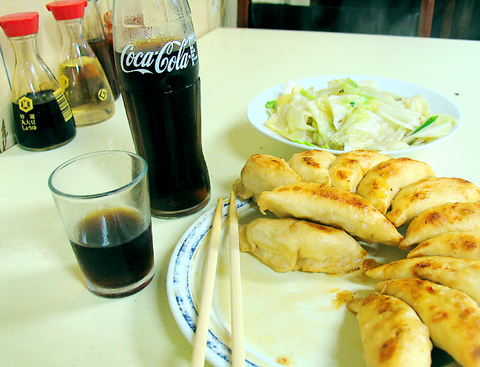Some restaurant reviews take a critical look at a popular eatery and others just point you in the right direction, i.e. take Nanjing Road west until you come to the circular glass building in the middle of the street, then look for the sushi place in the alley on the left; or, go the Wan-nian Building in Ximending and try the cold noodles in the stall at the bottom of the down escalator.
This review is more like that. So to cut to the chase, if you're interested in trying some of the best pot stickers in town, go past Minquan East Road heading north on Zhongshan and check out Dou Jin-ying's (

PHOTO: DAVID MOMPHARD, TAIPEI TIMES
Hers are better pot stickers than others I've tried because the bread wrappings are thicker than the average dumpling. The result is, when fried, the outside becomes a bit crispy and chewy.
Use a chopstick to punch a hole in the crust of each -- the pork stuffing is scalding hot. Pour a bit of soy sauce in a ramekin, dab in some chili and you're ready to go. I recommend ordering a Coke because it's the perfect compliment to the dipping sauce and helps cuts the grease from the pot stickers.
The grease is worth mentioning, actually, because of the grill that produces it. Dou's place has been frying up pot stickers in the same kitchen since 1958 and the grill has nearly a half-century of seasoning burned into it. Her mother ran the place before her and can still be seen each night at her table by the kitchen, quietly letting everyone know she's still the boss.
Disclosure: I may be partial to Dou's pot stickers because they were the first I had after arriving in Taipei some years ago. And I ate them frequently after that. I'd order a slab of 20, wash them down with a bottle of Coke, and waddle back to work.
A general "Anyone for pot stickers?" asked to the office usually solicited several positive responses back then. They're likely still a favorite dinner option for those who work at that office now. They still are for me.
If you try them and find they're not your thing, check out the cold noodles in Ximending. Take the escalator to the basement of the Wan-nian Building and hang a left.

The canonical shot of an East Asian city is a night skyline studded with towering apartment and office buildings, bright with neon and plastic signage, a landscape of energy and modernity. Another classic image is the same city seen from above, in which identical apartment towers march across the city, spilling out over nearby geography, like stylized soldiers colonizing new territory in a board game. Densely populated dynamic conurbations of money, technological innovation and convenience, it is hard to see the cities of East Asia as what they truly are: necropolises. Why is this? The East Asian development model, with

June 16 to June 22 The following flyer appeared on the streets of Hsinchu on June 12, 1895: “Taipei has already fallen to the Japanese barbarians, who have brought great misery to our land and people. We heard that the Japanese occupiers will tax our gardens, our houses, our bodies, and even our chickens, dogs, cows and pigs. They wear their hair wild, carve their teeth, tattoo their foreheads, wear strange clothes and speak a strange language. How can we be ruled by such people?” Posted by civilian militia leader Wu Tang-hsing (吳湯興), it was a call to arms to retake

This is a deeply unsettling period in Taiwan. Uncertainties are everywhere while everyone waits for a small army of other shoes to drop on nearly every front. During challenging times, interesting political changes can happen, yet all three major political parties are beset with scandals, strife and self-inflicted wounds. As the ruling party, the Democratic Progressive Party (DPP) is held accountable for not only the challenges to the party, but also the nation. Taiwan is geopolitically and economically under threat. Domestically, the administration is under siege by the opposition-controlled legislature and growing discontent with what opponents characterize as arrogant, autocratic

Desperate dads meet in car parks to exchange packets; exhausted parents slip it into their kids’ drinks; families wait months for prescriptions buy it “off label.” But is it worth the risk? “The first time I gave him a gummy, I thought, ‘Oh my God, have I killed him?’ He just passed out in front of the TV. That never happens.” Jen remembers giving her son, David, six, melatonin to help him sleep. She got them from a friend, a pediatrician who gave them to her own child. “It was sort of hilarious. She had half a tub of gummies,